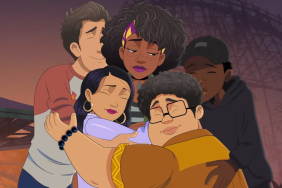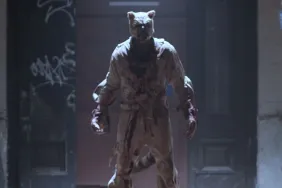Returning to the deep with Dinoshark & Sharktopus!

For fans of horror and sci-fi Roger Corman does not require an introduction. The legendary filmmaker, with nearly 400 credits and counting, is essentially his own genre. When it comes to making movies Corman is as passionate as ever. A new partnership with the Syfy Channel begins on March 13 with the premiere of Dinoshark, starring Eric Balfour, and the much-buzzed about Sharktopus is currently in production. Hollywood is also busy remaking his movies. Death Race was released in 2008 and Piranha hits theaters this August.
Briefly in Boston to take part in a tribute to Jonathan Demme, one of his many famous protégés, Mr. Corman took time from his busy schedule to speak with Shock Till You Drop before returning to home and work in Los Angeles. An enormously classy and interesting guy, Corman discusses his attraction to horror, how he feels about remakes, the genesis of his ideas, what it takes to make a good creature feature and much more.
Shock Till You Drop: What was your initial attraction to the horror genre?
Roger Corman: My initial attraction was both to horror and science fiction. In the horror vein I had read “The Complete Works of Edgar Allen Poe.” When I was a teenager I read “The Fall of the House of Usher” as a school assignment and loved it. So I asked my parents for the complete works for a Christmas present. They were delighted to give it to me because I could have asked for a shotgun or who knows what. Then I was an engineering student and got a degree in engineering, and that led me to science fiction. Those are the ostensible reasons. The real reasons are undoubtedly buried in my unconscious somewhere and I’m not even aware of what they are.
Shock: When did you first realize you wanted to make these kinds of movies for a living?
Corman: The very first picture I produced I called It Stalked the Ocean Floor. The distributor I sold it to thought that was too arty a title and changed it to Monster from the Ocean Floor. It was a science fiction/horror film. I think I was drawn to it for both the science fiction and horror aspects as well as the realization that I had very little money. I raised about $12,000 for it and the rest of it was deferred. I think it came to about $28,000 total. Of course that was in the 1950s. Today that would be about $100,000, maybe a little more. So first I was drawn to the genre and second I realized that this was one genre in which you didn’t need stars. The idea sold itself.

Well, technology comes very close to the top. So briefly, better cameras, better sound, computer graphics and better special effects. One of the other changes is the fact that we are starting to deal more with ideas in science fiction today. Previously science fiction was straight action or straight creature films. Now we are starting to deal with what science fiction classically has done which is to use it as a metaphor for human existence and human problems. That makes it a much more interesting and vital subject.
Shock: What is your opinion of the horror and science fiction genres as they exist today?
Corman: Science fiction is part of some of the best films ever made. Jim Cameron, who started with me as a science fiction model maker, has just made what I consider the great science fiction picture ever made [Avatar]. Technically there is nothing like it. He is years and years ahead of everybody else. I was at a party with him a couple of weeks ago and I told him that he is five or ten years ahead of everybody else. By the time they catch up with him he will be five or ten years ahead of them. Also, the ideas expressed in Avatar, although they have been expressed in other films, they are still interesting ideas about the environment, imperialism, and the power of corporations. The film stands on a very interesting set of ideas and phenomenal technology. It is interesting that two pictures came out this year that so clearly use science fiction as metaphors. The other is District 9, which clearly refers to apartheid and the oppression of people everywhere.
Shock: So do you think that science fiction is in a better place right now than horror?
Corman: Yes. Horror, at least the way I worked with horror, worked pretty much with suggestion. Today horror is working heavily with just straight gore. When cutting off somebody’s arm, the first director cuts it off at the wrist, and the next one cuts it off at the elbow, and the next cuts it off at the shoulder. It’s become a slasher genre. There are other types, like Martin Scorsese’s Shutter Island [writer’s note: another director who got his start with Corman], that could be called a horror film though it isn’t a horror film per se. But he uses many of the techniques of a horror film, and that is closer to classic horror, the type of horror I’ve worked with.
Shock: Many of your movies have been remade, including Piranha, which comes out later this year. How do you feel about your movies getting remade?
Corman: It all depends on whether or not I own the rights. I don’t own the rights for the remake of Piranha so I get nothing. I do own the rights to Death Race 2000 so when that was remade I went along as executive producer and was very pleased with the work. I have no real objection to it. There is not that much originality in any art form. I prefer to be original. I have remade one or two of my own films but in general I prefer originality. However I can understand the economic reasons for remaking a film.

This all started a few years ago with a picture called Dinocroc. I started with the title and sold it to Syfy. It got a very high rating and they asked me to make Supergator as a follow-up. It also got a high rating and then they asked me to make Dinoshark. I think it’s the best of this type and Syfy is so pleased with it they asked me to make Sharktopus. Sharktopus presents a different problem because if I do Dinocroc or Dinoshark I can understand that at one time there was a prehistoric crocodile or prehistoric shark. There is no such thing as a half shark/half octopus. It was their title and I had to come up with some kind of explanation. So what I came up with is a company called Blue Water, which is under contract with the Navy. It is a bioengineering firm. Pirates or terrorists use small boats to attack different areas where the Navy officially cannot go, so they commissioned Blue Water to design a half shark/half octopus. There’s something implanted in its brain they can control. The tentacles can overturn the boat and then the shark eats the terrorists. People who tune in to see Dinoshark or Sharktopus, that is what they want to see. I ask them to accept this one fantastic explanation. Once we establish that, then we’re completely logical. We don’t ask them to accept anything that couldn’t really happen.
Shock: What are the necessary components of a good creature feature?
Corman: One, the creature itself. You have to find something that is at least vaguely original. This is a problem because so much has been done. Sharktopus is about as original as you can get. The next is it must be terrifying. Third, you must present it in a suspenseful way. You can’t just have an attack from the creature. You must build the suspense to the point where the creature attacks. So it’s not just the creature itself but the way it is presented.
Shock: Do you feel that Syfy really gets these movies? That you are kind of kindred spirits?
Corman: Yes, I do. They have a very good staff, one that is interested in science fiction and horror. They like to combine the two and I have gotten along really well with them. We’ll be finishing Sharktopus in about two weeks and we’re already discussing a couple of other projects.
Shock: What keeps you passionate about continuing to make movies?
Corman: I simply love the process of making motion pictures. I have no intention of retiring. I’m not interested in golf and I don’t want to sit by the ocean and stare at the waves. I prefer to make films. It’s an exciting, creative process. It gives me creative satisfaction. I’m making fewer films than I formerly did. We used to make 10-12 films a year and sometimes more. Weâre making about 4 or 5 films a year now because frankly I just don’t want to work that hard.

It is definitely possible. It’s a more difficult game today because when I started all our films got full theatrical releases. Today very few low-budget films get a theatrical release. The possibility of a big profit is greatly diminished though there is still the possibility, if you make a good film, of making a reasonable profit. As to the films themselves, it’s actually easier shooting digitally. It is cheaper and more efficient than shooting on film, so the actual process is easier today than it was when I started.
Shock: Has it ever bothered you that the horror and science fiction genres never got much critical respect or do you not really think about it?
Corman: I accept it. It’s simply a fact of life. Occasionally a horror or science fiction picture will be accepted and recognized, going all the way back to German films like The Cabinet of Dr. Caligari and Nosferatu. My Edgar Allen Poe films got a little bit of critical attention and so did Frankenstein, Dracula and the Universal films from the ’30s as well as the Val Newton films from the ’40s, so occasionally some of them do get some critical attention.
Catch a sneak peek at Dinoshark here!
Source: Paul Doro










